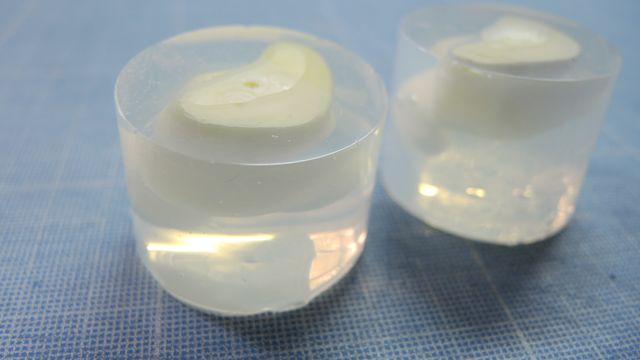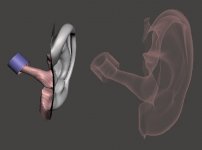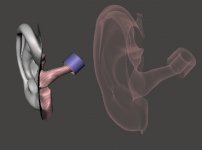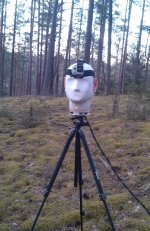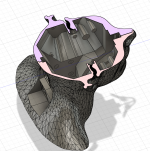Not only in your opinion.
Did I mention it took me over two years to model my ears? 🙂
And yes, the canal inside looks very much alike the blue molds in the picture.
Did I mention it took me over two years to model my ears? 🙂
And yes, the canal inside looks very much alike the blue molds in the picture.
You just have to make a negative mold... and you are done !
]
I wish it was that easy!
The negative mold would only copy that specific canal.
It wouldn't be an averaged canal intended to work for the majority of people.
It would also be a physical object, not a 3D printable model suited for repeatable consistent prints.
And lastly, it would just be the canal. There would be no smooth transition with the pinna, and it would lack the base for adjustable angle choice and flush mount.
I did not just 'wing it' with this model, believe me. That's not how things should be done in audio, and definitely not how I do things in general.
If you can come up with a similar product on your own, I will gladly buy it even at double the price I sell my models.
It would still be a deal IMHO.
Last edited:
I unshared my Dropbox folder mentioned on post #5.
If somebody would like to listen to samples of my recordings they are more than welcome to PM me.
If somebody would like to listen to samples of my recordings they are more than welcome to PM me.
https://www.dropbox.com/sh/strkpn3r6ewcy2w/AAAKQI5RfG0Z4l8aMrlvp48la?dl=0
404.
You should perhaps put it on soundcloud 😉
https://soundcloud.com/
404.
You should perhaps put it on soundcloud 😉
https://soundcloud.com/
It's 404 because I unshared it.
I don't want to share my recordings anywhere public on the internet.
But again, if somebody is interested I can share the demos privately.
I don't want to share my recordings anywhere public on the internet.
But again, if somebody is interested I can share the demos privately.
An updated description on my shop page (https://www.shapeways.com/shops/binaural-microphone-ears) explains a little better why using ear canals with binaural microphones delivers a more realistic sound.
Why anatomically accurate ear canals?
Evolution provided us with ears to be able to hear our surroundings.
Eardrums are the auditory transducers that sense air pressure and, through the middle and inner ear, provide signals to the brain.
Our brain's constant processing of left and right eardrum sensed pressure inputs is what makes us hear. These inputs vary depending on the nature of the source, but also on the source location in respect to the listener.
Our head, pinnae and ear canals play a fundamental role in shaping the pressure frequency content that reaches the eardrums, applying filters that are location dependent and known as Head Related Transfer Functions (HRTFs).
Their geometry literally shapes the sound wave before it hits the eardrum, so that the brain is able to interpret left and right eardrum signals correctly and recognize and locate the sounds around us.
Without ears and ear canals, localization and sound recognition are compromised.
Binaural recordings aim at encoding the pressure that our eardrums would sense if our heads where in the place of the microphone directly on the records, to be able to be retrieved by our brain during playback.
To provide the microphones with the correct sound pressure waves it is therefore essential to use anatomically accurate replicas of the pinnae and the ear canals, in a binaural microphone. This ensures that the left and right microphone sensed pressures encoded in the recording are the same ones that our eardrums would experience, for our brain to interpret them and let us enjoy the ultimate in sound accuracy and realism.
Why anatomically accurate ear canals?
Evolution provided us with ears to be able to hear our surroundings.
Eardrums are the auditory transducers that sense air pressure and, through the middle and inner ear, provide signals to the brain.
Our brain's constant processing of left and right eardrum sensed pressure inputs is what makes us hear. These inputs vary depending on the nature of the source, but also on the source location in respect to the listener.
Our head, pinnae and ear canals play a fundamental role in shaping the pressure frequency content that reaches the eardrums, applying filters that are location dependent and known as Head Related Transfer Functions (HRTFs).
Their geometry literally shapes the sound wave before it hits the eardrum, so that the brain is able to interpret left and right eardrum signals correctly and recognize and locate the sounds around us.
Without ears and ear canals, localization and sound recognition are compromised.
Binaural recordings aim at encoding the pressure that our eardrums would sense if our heads where in the place of the microphone directly on the records, to be able to be retrieved by our brain during playback.
To provide the microphones with the correct sound pressure waves it is therefore essential to use anatomically accurate replicas of the pinnae and the ear canals, in a binaural microphone. This ensures that the left and right microphone sensed pressures encoded in the recording are the same ones that our eardrums would experience, for our brain to interpret them and let us enjoy the ultimate in sound accuracy and realism.
Two pieces recorded with my ear models:
https://www.youtube.com/watch?v=b1mtKjdgQi0
https://www.youtube.com/watch?v=yr84sneJcJk
Only equalization applied, other than the binaural microphone's own EQ, was to make it sound warmer, per customer's request.
No compression, reverb or anything else.
Mic location about 20-23 ft from singer.
Video editing done by Emma.
https://www.youtube.com/watch?v=b1mtKjdgQi0
https://www.youtube.com/watch?v=yr84sneJcJk
Only equalization applied, other than the binaural microphone's own EQ, was to make it sound warmer, per customer's request.
No compression, reverb or anything else.
Mic location about 20-23 ft from singer.
Video editing done by Emma.
In between some other audio related projects I have had (and still have) going on, I finally got around to write down a more technical and concise explanation of the theory underlying binaural recordings, among which the need to include ear canal replicas when one's main concern is accurate reproduction of the real event.
Binaural Theory - Gearslutz
Binaural Theory - Gearslutz
Several years ago i made my binaural head.I thought that ear canal is important, so I have tried it with and without ear canal.My ear canal is kind of straight shape silicone material. That was no way a scientific test, but i recorded noise of plastic bag crushed between hands 0.5meters in front of the head and 0.5meters behind the head. with ear canal and without.
Recorded sounds without ear canal in front and in the back are very similar and impossible to tell with confidence which one is frontal. With ear canal is better, and i could tell where was frontal sound, because of bigger differences in high frequencies. Later i compared this with real world test. Closed my eyes and asked my wife to make that plastic bag sound. And without head movement and visual cues frontal/back sound difference is not so obvious you would imagine. So i was very happy with my binaural head.
Interesting thing that scientific papers says that blocked air canal captures all the directional info. And ear canal just adds its transfer function on top of that. (hence direction independent). Common sense tells that pina+ear canal is one direction dependant system and cannot be analysed independently. But i did't find papers fully supporting this.I am engineer and i am looking for the answers.
You say that
"On the other hand, it is equally wrong to assume that the binaural status quo of the capsule being located at the canal’s entrance must not be messed with and regard it as the end all be all of binaural technology. Math disproves this."
Can you point to any paper or some thoughts about that "Math disproves this"?
And the second question is about your silicone ears. How did you managed to do averaged ear canal? How did you get correct measurements of human ear canals??
Recorded sounds without ear canal in front and in the back are very similar and impossible to tell with confidence which one is frontal. With ear canal is better, and i could tell where was frontal sound, because of bigger differences in high frequencies. Later i compared this with real world test. Closed my eyes and asked my wife to make that plastic bag sound. And without head movement and visual cues frontal/back sound difference is not so obvious you would imagine. So i was very happy with my binaural head.
Interesting thing that scientific papers says that blocked air canal captures all the directional info. And ear canal just adds its transfer function on top of that. (hence direction independent). Common sense tells that pina+ear canal is one direction dependant system and cannot be analysed independently. But i did't find papers fully supporting this.I am engineer and i am looking for the answers.
You say that
"On the other hand, it is equally wrong to assume that the binaural status quo of the capsule being located at the canal’s entrance must not be messed with and regard it as the end all be all of binaural technology. Math disproves this."
Can you point to any paper or some thoughts about that "Math disproves this"?
And the second question is about your silicone ears. How did you managed to do averaged ear canal? How did you get correct measurements of human ear canals??
Attachments
Hi Baffless.
Glad to hear you came to similar conclusions by practical trial and error.
Theory is good and all, but there's nothing like making stuff work in practice 🙂
As you said, pinna and canal can't be analysed independently, but they work as a pinna+canal whole system. You might look into the work of Angelo Farina too, if you already haven't.
As far as the math goes, it's in the compendium I wrote. Specifically, the part that explains how to make the required EQ independent from the direction of arrival, M needs to be equal to H (Microphone needs to have the same shape of the Head).
Also, physics tells us that by closing the canal at the entrance, one effectively distorts the soundwave in respect of the open ear canal scenario.
So, not only one should't look at the pressure at the ear canal entrance if they want to capture all binaural cues, but capturing the pressure at that point in space would require the use of an infinitesimally small capsule. Anything else and the geometry changes, and the soundwave is distorted as a consequence.
The model for the canal was derived by averaging hundreds of real life casts.
Glad to hear you came to similar conclusions by practical trial and error.
Theory is good and all, but there's nothing like making stuff work in practice 🙂
As you said, pinna and canal can't be analysed independently, but they work as a pinna+canal whole system. You might look into the work of Angelo Farina too, if you already haven't.
As far as the math goes, it's in the compendium I wrote. Specifically, the part that explains how to make the required EQ independent from the direction of arrival, M needs to be equal to H (Microphone needs to have the same shape of the Head).
Also, physics tells us that by closing the canal at the entrance, one effectively distorts the soundwave in respect of the open ear canal scenario.
So, not only one should't look at the pressure at the ear canal entrance if they want to capture all binaural cues, but capturing the pressure at that point in space would require the use of an infinitesimally small capsule. Anything else and the geometry changes, and the soundwave is distorted as a consequence.
The model for the canal was derived by averaging hundreds of real life casts.
B&K's new HATS Type 5128 includes anatomically accurate ear canals.
https://www.bksv.com/en/about/waves...4LxRBGZamlRks67veMTELorxW2e8jT8kVmmGRx5R4w5ZM
GRAS KB5000 does the same.
GRAS KB5000 Right Anthropometric Pinna 35 Shore OO
https://www.bksv.com/en/about/waves...4LxRBGZamlRks67veMTELorxW2e8jT8kVmmGRx5R4w5ZM
GRAS KB5000 does the same.
GRAS KB5000 Right Anthropometric Pinna 35 Shore OO
depends on application. If records will be reproduced over loudspeakers, i will subtract head/ear introduced difference depending on speakers placement angle.
What I meant is are you going to use hardware DSP or leave it to the DAW?
I don't think loudspeaker reproduction requires any particularly separate EQ.
The difference between loudspeakers and headphones is accounted for by the headphones own EQ, which is why you can listen to the same song with loudspeakers or headphones without any (major) change in balance.
I don't think loudspeaker reproduction requires any particularly separate EQ.
The difference between loudspeakers and headphones is accounted for by the headphones own EQ, which is why you can listen to the same song with loudspeakers or headphones without any (major) change in balance.
i leave it to the DAW, because i need flexibility.And the design would become quite complicated otherwise. Would have to deal with noise,EMI,lots off hardware inside head.Want to keep design simple. Theoretically it will be rain proof🙂 will see how it goes..
If you intend to sell it and you have the means I would suggest you also provide some base plug in EQ. So that people can plug and play.
Anything DIY tends to turn the majority of people away.
Anything DIY tends to turn the majority of people away.
i have found very good paper on ear canal directional dependency.
https://vbn.aau.dk/files/227875888/1996_Hammersh_i_and_M_ller_JASA.pdf
it looks like above 10khz ear canal could start to become direction dependant.
above 10khz variations from person to person are very high, but good thing is that for dummy head microphone this is not o problem, because transfer function of dummy head is well known. So can be compensated, at least for one sound arrival angle.And directional info will still be left. This is kind of analogy where common mode signal is discarded and only the difference signal is taken in balanced circuits.
My dummy head parts arrived, so after assembly i will do some measurements, and share some info.
https://vbn.aau.dk/files/227875888/1996_Hammersh_i_and_M_ller_JASA.pdf
it looks like above 10khz ear canal could start to become direction dependant.
above 10khz variations from person to person are very high, but good thing is that for dummy head microphone this is not o problem, because transfer function of dummy head is well known. So can be compensated, at least for one sound arrival angle.And directional info will still be left. This is kind of analogy where common mode signal is discarded and only the difference signal is taken in balanced circuits.
My dummy head parts arrived, so after assembly i will do some measurements, and share some info.
- Home
- Vendor's Bazaar
- DIY Binaural Microphone Ears With Anatomically Accurate Ear Canals
